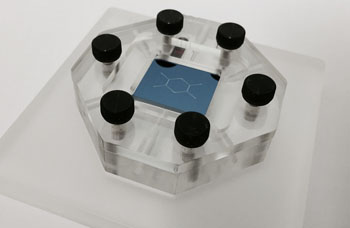Lab-on-a-Chip Technology Breaks New Bioparticle Separation Record
By LabMedica International staff writers
Posted on 23 Aug 2016
Scientists have developed a new lab-on-a-chip technology that can, for the first time, separate biological particles at the nanoscale down to 20 nanometers in diameter, a scale that gives access to important particles such as DNA, viruses, and exosomes. The breakthrough could enable detection of various diseases before symptoms appear and would facilitate use of relatively noninvasive liquid biopsies.Posted on 23 Aug 2016
The device was developed by a team led by scientists from IBM Thomas J Watson Research Center (Yorktown Heights, NY, USA). Once separated, these particles can be analyzed to potentially reveal signs of disease even before patients experience physical symptoms and when the outcome from treatment is most positive. Until now, the smallest bioparticle that could be separated by size with on-chip technologies was about 50 times or larger, for example, separation of circulating tumor cells from other biological components. The study results also showed that separation can take place despite diffusion, a hallmark of particle dynamics at these small scales.

Image: The nano-DLD chip (2 cm x 2 cm) mounted in a microfluidic jig. The technology allows a liquid sample to be passed, in continuous flow, through a silicon chip containing an asymmetric pillar array that allows sorting a microscopic waterfall of nanoparticles, separating particles by size down to 20 nanometer resolution (Photo courtesy of IBM Research).
IBM Research partnered with the Icahn School of Medicine at Mount Sinai (NY, USA) to develop exosome-based liquid biopsies using IBM’s nano technology, and will continue the collaboration to further develop this lab-on-a-chip and to test it on prostate cancer.
In precision medicine, exosomes are increasingly being viewed as valuable biomarkers to help reveal the origin and nature of a cancer and for diagnosis and prognosis of malignant tumors. Exosomes are released in easily accessible bodily fluids such as blood, saliva, or urine. The IBM team targeted exosomes with their lab-on-chip technology due to the challenges facing existing techniques for separating and purifying exosomes in liquid biopsies. Exosomes range in size from 20-14 nm and contain information about the health of the originating cell that they are shed from. A determination of the size, surface proteins, and nucleic acid cargo carried by exosomes can give essential information about the presence and state of developing cancer and other diseases. With Mount Sinai, IBM hopes to confirm their technology can pick up exosomes with cancer-specific biomarkers from patient liquid biopsies.
“The ability to sort and enrich biomarkers at the nanoscale in chip-based technologies opens the door to understanding diseases such as cancer as well as viruses like the flu or Zika,” said Gustavo Stolovitzky, program director, Translational Systems Biology and Nanobiotechnology, IBM Research.
With the ability to sort bioparticles at the nanoscale, Mount Sinai hopes that IBM’s technology can provide a new method to eavesdrop on cell-to-cell messages carried by exosomes, to monitor this intercellular conversation. “When we are ahead of the disease we usually can address it well; but if the disease is ahead of us, the journey is usually much more difficult. One of the important developments that we are attempting in this collaboration is to have the basic grounds to identify exosome signatures that can be there very early on before symptoms appear or before a disease becomes worse,” said Carlos Cordon-Cardo, MD, PhD, Mount Sinai Health System, and Icahn School of Medicine, “By bringing together Mount Sinai’s domain expertise in cancer and pathology with IBM’s systems biology experience and its latest nanoscale separation technology, the hope is to look for specific, sensitive biomarkers in exosomes.”
Using a technology called nanoscale deterministic lateral displacement, or nano-DLD, IBM scientists Joshua Smith and Benjamin Wunsch led development of a lab-on-a-chip technology that allows a liquid sample to be passed, in continuous flow, through a silicon chip containing an asymmetric pillar array. This array allows the system to sort a microscopic waterfall of nanoparticles, separating particles by size down to resolution of 10s of nanometers. IBM has already scaled down the chip size to 2cm by 2cm, while continuing development to increase the technology density to improve functionality and throughput. Leveraging IBM’s vast semiconductor expertise with its growing capabilities in experimental biology, the scientists used manufacturable silicon processes to produce the nano-DLD arrays for their lab-on-a-chip technology.
Much like how a road through a small tunnel only allows smaller cars to pass while forcing bigger trucks to detour around, nano-DLD uses a set of pillars to deflect larger particles while allowing smaller particles to flow through the gaps of the pillar array unabated, effectively separating this particle traffic by size while not disrupting flow. The scientists noticed that nano-DLD arrays can also split a mixture of many different particle sizes into a spread of streams, somewhat like a prism splits white light into different colors. The continuous flow nature of this technology circumvents stop-and-go batch processing typical of conventional separation techniques.
The study, by Wunsch BH et al, was published online August 1, 2016, in the journal Nature Nanotechnology.
Related Links:
IBM Thomas J Watson Research Center














